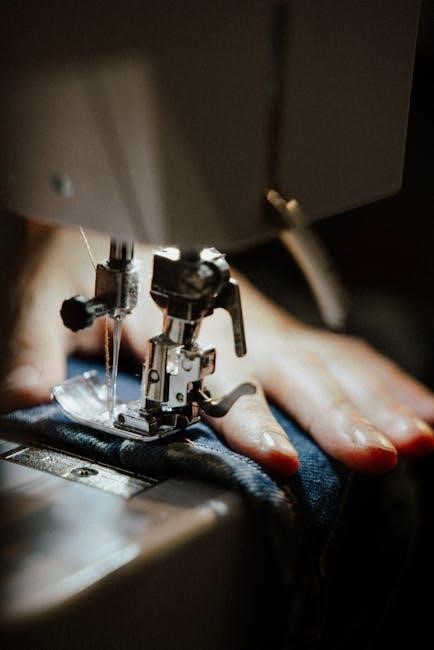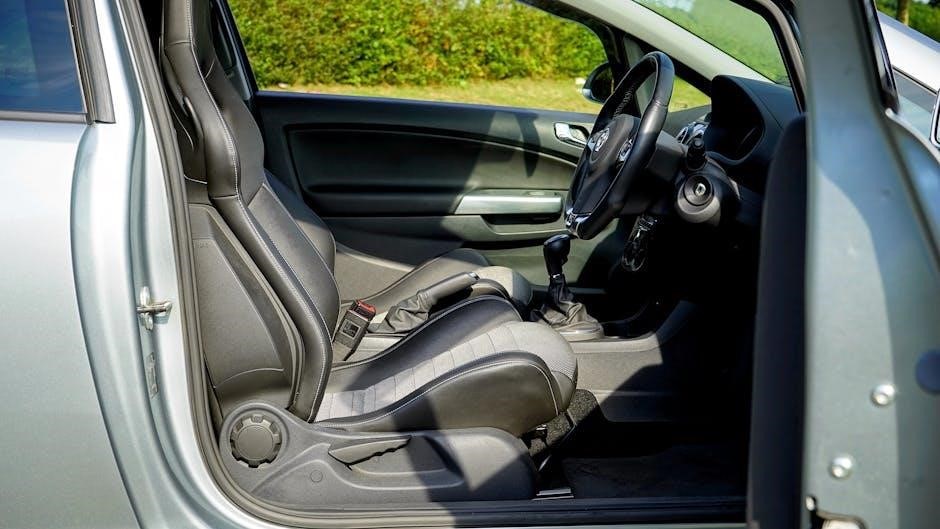This manual provides a comprehensive guide for the Singer 99K sewing machine, detailing its features, setup, and maintenance. It helps users optimize their sewing experience, whether they’re beginners or experienced sewists, ensuring they master the machine’s capabilities effectively.
1.1 Overview of the Singer 99K Model
The Singer 99K is a mechanical sewing machine introduced in the 1950s, known for its durability and versatility. It was available in both hand crank and electric versions, catering to different user preferences. Designed for home sewists and small-scale manufacturers, the 99K model is celebrated for its simplicity and reliability. The machine features basic stitch options, making it ideal for everyday sewing tasks. Its compact design and robust construction have made it a favorite among sewing enthusiasts. The Singer 99K manual is essential for understanding its operation, maintenance, and full potential, ensuring users can maximize its capabilities for various sewing projects.
1.2 Importance of the Manual for Optimal Usage
The Singer 99K manual is crucial for understanding the machine’s full potential. It provides detailed instructions for setup, operation, and maintenance, ensuring users can troubleshoot common issues and optimize performance. The manual includes guidance on threading, bobbin winding, and stitch selection, which are essential for achieving professional results. Whether you’re a novice or an experienced sewist, the manual serves as an invaluable resource for mastering the machine’s capabilities. Regular reference to the manual helps maintain the machine’s longevity and ensures seamless operation for years to come.

History and Evolution of the Singer 99K
The Singer 99K, introduced in the 1950s, is a durable and versatile sewing machine. Its electric model gained popularity for its reliability and ease of use.
2;1 Development and Release in the 1950s
The Singer 99K sewing machine was developed and released in the 1950s, marking a significant milestone in sewing technology. Known for its durability and versatility, it was designed to cater to both home sewists and small-scale industrial use. The machine was available in two versions: a hand crank model and an electric model, with the latter gaining popularity for its ease of use and efficiency. The Singer 99K featured a robust mechanical design, making it suitable for a wide range of fabrics and sewing tasks. Its release coincided with a growing demand for reliable sewing machines, and it quickly became a favorite among seamstresses and tailors due to its consistent performance and longevity.
2.2 Key Differences Between Class 99 and 99K Models
The Singer Class 99 and 99K models share a similar mechanical framework but have distinct features. The Class 99 is the earlier version, while the 99K was introduced later with slight improvements. One notable difference is the 99K’s compatibility with both hand crank and electric operation, offering more versatility. Additionally, the 99K includes a wider range of stitch options and enhanced tension control for better sewing results. The 99K also features minor design upgrades, such as a more durable finish and improved accessory compatibility. These subtle differences make the 99K more adaptable for various sewing tasks, catering to both hobbyists and professionals seeking reliability and flexibility in their projects.

Features and Specifications of the Singer 99K
The Singer 99K sewing machine is known for its durability and versatility, offering a range of stitch options and compatible with both hand crank and electric operation.
3.1 Mechanical and Electrical Components
The Singer 99K features a robust motor located at the back, designed for both alternating and direct current operation. Its mechanical components include a durable gearbox and a rotating hook, ensuring smooth stitching. The machine is compatible with hand crank and electric models, offering versatility. Electrical specifications require stating voltage and cycles for proper motor function. Genuine Singer needles and oil are recommended for optimal performance, ensuring longevity and reliability. These components collectively make the Singer 99K a reliable choice for various sewing tasks, maintaining its reputation as a dependable vintage sewing machine.
3.2 Compatibility with Hand Crank and Electric Models
The Singer 99K is uniquely designed to accommodate both hand crank and electric operations, offering flexibility for different sewing preferences. The hand crank model allows for manual control, ideal for precision and portability, while the electric version provides convenience and efficiency for heavier use. Users can easily switch between modes, ensuring adaptability to various sewing projects. This dual compatibility makes the Singer 99K a versatile choice, catering to both traditional and modern sewing needs. The machine’s design ensures seamless performance regardless of the power source, maintaining consistent stitch quality and reliability.

Operating the Singer 99K Sewing Machine
Operating the Singer 99K sewing machine is straightforward, with clear guidance in the manual for setup, threading, stitch selection, and attachment usage, ensuring efficient sewing for all skill levels.

4.1 Setting Up the Machine for First Use
Setting up the Singer 99K sewing machine for first use involves unpacking, inspecting, and preparing the machine. Ensure all accessories like needles, bobbins, and oil are included. Before use, apply Singer oil to the mechanical components as instructed to ensure smooth operation. Place the machine on a stable surface and, for electric models, plug it into a compatible power source. For hand-crank models, attach the crank securely. Familiarize yourself with the control dials and stitch selection. Refer to the manual for specific setup instructions tailored to your model. Proper initial setup ensures optimal performance and longevity of your Singer 99K sewing machine.
4.2 Threading and Bobbin Winding Techniques
Proper threading and bobbin winding are essential for smooth operation of the Singer 99K. Begin by threading the machine with the presser foot raised, following the guide on the manual. Ensure the thread passes through the tension discs and take-up lever correctly. For the bobbin, wind it evenly, avoiding overfilling, and secure it in the bobbin case. Always use high-quality thread and genuine Singer needles to prevent breakage. If threading incorrectly, rethread completely, as partial adjustments can lead to uneven stitches or machine jamming. Regularly check and replace the bobbin to maintain consistent stitching quality and extend the machine’s lifespan.
4.3 Selecting Stitches and Managing Tension
Selecting the right stitch and managing tension are crucial for achieving professional results with the Singer 99K. The machine offers various stitch options, including straight and zigzag, which can be selected using a dial or lever. Always refer to the manual for specific stitch settings. Proper thread tension ensures even stitching; adjust the upper thread tension dial and bobbin tension screw as needed. If stitches are uneven or puckering occurs, check and adjust the tension. For consistent results, use Singer-recommended needles and threads. Regularly test stitches on scrap fabric before starting projects. Proper tension and stitch selection enhance fabric handling and prevent common sewing issues, ensuring high-quality finishes every time.
4.4 Using Attachments for Versatile Sewing
The Singer 99K sewing machine supports various attachments to enhance versatility in sewing projects. These include zipper feet, buttonhole attachments, and hemmers, which can be easily installed to handle specific tasks. Attachments are typically provided with the machine or can be purchased separately. To use them, refer to the manual for installation instructions. Each attachment is designed to simplify tasks like sewing zippers, creating buttonholes, or stitching straight hems. Experimenting with different attachments allows users to explore a wide range of creative possibilities. Always ensure attachments are securely fitted to maintain proper machine function. The manual provides detailed guidance on compatible attachments and their uses, helping users maximize the machine’s potential for diverse sewing needs.

Maintenance and Care Tips
Regular cleaning and lubrication are essential to maintain the Singer 99K’s performance. Use Singer oil for lubrication and genuine Singer needles for optimal stitching results. Clean dust regularly.
5.1 Regular Cleaning and Lubrication
Regular cleaning and lubrication are vital for maintaining the Singer 99K’s optimal performance; Use a soft brush to remove dust and debris from the machine’s interior and exterior. Lubricate moving parts with Singer oil, as specified in the manual, to ensure smooth operation. Avoid using household oils, as they may damage the machine. Clean the bobbin area and feed dogs regularly to prevent thread jams. Check the motor, located at the back, and ensure it is free from dust. Proper care extends the machine’s lifespan and ensures consistent stitching quality. Always use genuine Singer needles and follow the manual’s guidelines for maintenance.
5.2 Troubleshooting Common Issues
Common issues with the Singer 99K include thread jams, uneven stitching, and motor noise. To address thread jams, check the bobbin alignment and ensure the needle is properly threaded. For uneven stitches, verify tension settings and ensure the correct needle size is used. If the motor is noisy, inspect for dust buildup or insufficient lubrication. Refer to the manual for specific troubleshooting steps. Regular cleaning and lubrication can prevent many of these issues. If problems persist, consult the manual or contact Singer support for assistance. Proper maintenance and timely resolution of issues ensure the machine runs smoothly and delivers consistent results. Always follow the manual’s guidelines for troubleshooting and repair.

Singer 99K Electrical Information
The Singer 99K features an electric motor compatible with both AC and DC power. The motor is located at the back and requires specific voltage and cycle specifications for operation.
6.1 Motor Specifications and Power Requirements
The Singer 99K motor is designed for both alternating current (AC) and direct current (DC) operation. For AC, it requires specifying the number of cycles, typically 50 or 60 Hz. DC operation needs precise voltage matching. The motor’s power requirements are moderate, ensuring efficient energy use while maintaining robust performance. Proper voltage and current alignment are crucial for optimal functioning. Users must consult the manual or contact Singer representatives for exact specifications to avoid damage. This ensures the machine runs smoothly, delivering consistent stitching quality across various sewing tasks.
6.2 AC and DC Compatibility
The Singer 99K sewing machine is engineered to operate seamlessly with both alternating current (AC) and direct current (DC) power sources. This versatility allows users to adapt the machine to various electrical environments. For AC operation, the motor must be configured according to the specified voltage and cycle count, typically 50 or 60 Hz. DC operation requires precise voltage matching to ensure optimal performance. This dual compatibility enhances the machine’s versatility, making it suitable for different regions and power setups. Users are advised to refer to the manual for specific configuration details to avoid damage and ensure efficient operation. This feature underscores the Singer 99K’s adaptability and reliability across diverse electrical systems.

Accessories and Parts for the Singer 99K
Genuine Singer needles, oils, and attachments are essential for optimal performance. These accessories ensure durability and quality stitching. Users are advised to use authentic Singer parts for best results.
7.1 Genuine Singer Needles and Oils
Genuine Singer needles and oils are crucial for maintaining the performance and longevity of your Singer 99K sewing machine. Singer needles are designed specifically for compatibility, ensuring smooth stitching and preventing damage. Regular use of Singer oil keeps the machine well-lubricated, reducing friction and wear on moving parts. The manual emphasizes the importance of using only Singer-approved products, as they are tailored to the machine’s specifications. Using alternative or low-quality needles and oils may lead to subpar stitching, machine malfunction, or even permanent damage. Always purchase these essentials from authorized Singer dealers or trusted sources to guarantee authenticity and reliability. Proper maintenance with genuine parts ensures optimal results and extends the machine’s lifespan.
7.2 Optional Attachments for Enhanced Functionality
The Singer 99K sewing machine can be enhanced with optional attachments designed to expand its capabilities. These include various presser feet, such as zipper, buttonhole, and ruffler feet, which enable specialized stitching and precision. Additionally, quilting guides and embroidery attachments can be added for intricate designs and large-scale projects. These accessories are tailored to fit the Singer 99K seamlessly, ensuring optimal performance. Users can explore Singer’s official catalog or trusted sewing supply stores to find genuine attachments that maintain the machine’s quality and functionality. By incorporating these optional features, sewists can unlock new creative possibilities and achieve professional-grade results with their Singer 99K. Properly fitted attachments ensure durability and enhance the overall sewing experience.

Downloading and Accessing the Manual
The Singer 99K manual is readily available online as a free PDF download, accessible through various resources like Ismacs and ManualsOnline, suitable for both 99 and 99K models.
8.1 Online Resources for the Singer 99K Manual
Several online platforms offer free access to the Singer 99K manual, including ManualsOnline and Ismacs. These websites provide downloadable PDF versions of the manual, ensuring easy access for users. Additionally, Singer’s official website and other sewing communities host these resources, catering to both vintage and modern sewing enthusiasts. The manual is also available on forums and dedicated sewing machine archives, making it widely accessible. Users can search for specific models, such as the Singer 99 or 99K, to find the exact guide they need. These online resources are invaluable for anyone seeking to understand and maintain their Singer 99K sewing machine effectively.

8.2 Tips for Navigating the Digital Version
Navigating the digital version of the Singer 99K manual is straightforward with its organized structure. Use bookmarks to quickly access specific sections, such as setup, maintenance, or troubleshooting. The search function allows you to find keywords or topics instantly. Zoom in on detailed diagrams for clarity and print relevant pages for easy reference. Familiarize yourself with the table of contents to understand the manual’s layout. Save the PDF to your device for offline access and consider syncing it across multiple devices for convenience. These tips ensure a seamless experience, helping you find information quickly and make the most of your Singer 99K sewing machine.
The Singer 99K manual is your essential guide, offering detailed instructions and tips for optimal use. With proper care and knowledge, your machine will deliver lasting performance and creativity.
9.1 Final Thoughts on the Singer 99K Manual
9.2 Encouragement to Explore and Master the Machine
Embrace the Singer 99K sewing machine as a timeless tool for creativity and precision. With its robust construction and versatile features, it offers endless possibilities for sewing enthusiasts. Encourage yourself to explore its capabilities, starting with simple projects and gradually mastering more complex techniques. The manual serves as your guide, helping you unlock the machine’s full potential. Experiment with different stitches, attachments, and fabrics to discover what works best for you. Remember, practice and patience will refine your skills, making you a proficient sewist. By mastering the Singer 99K, you’ll not only extend its lifespan but also create beautiful, lasting pieces that reflect your dedication and creativity.



